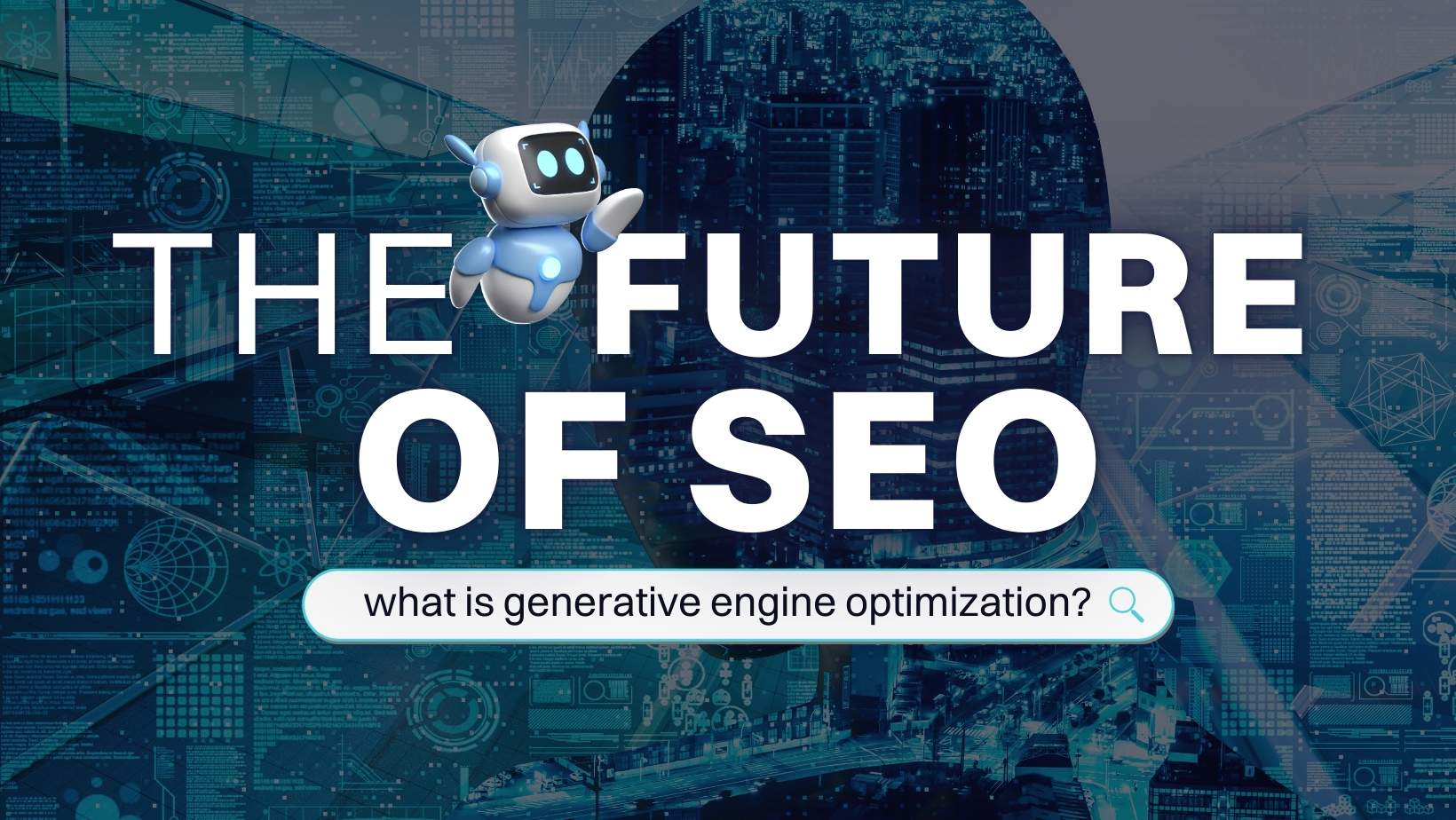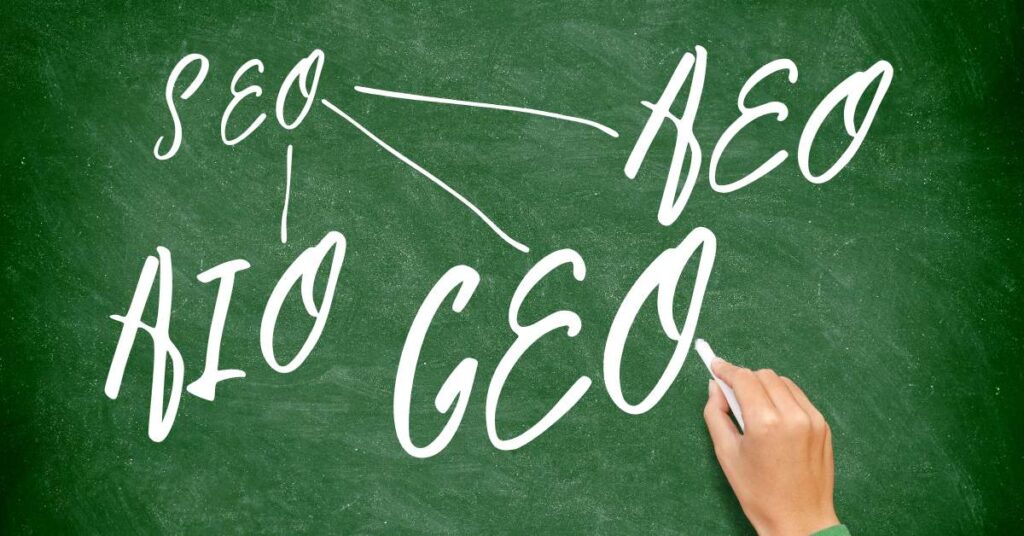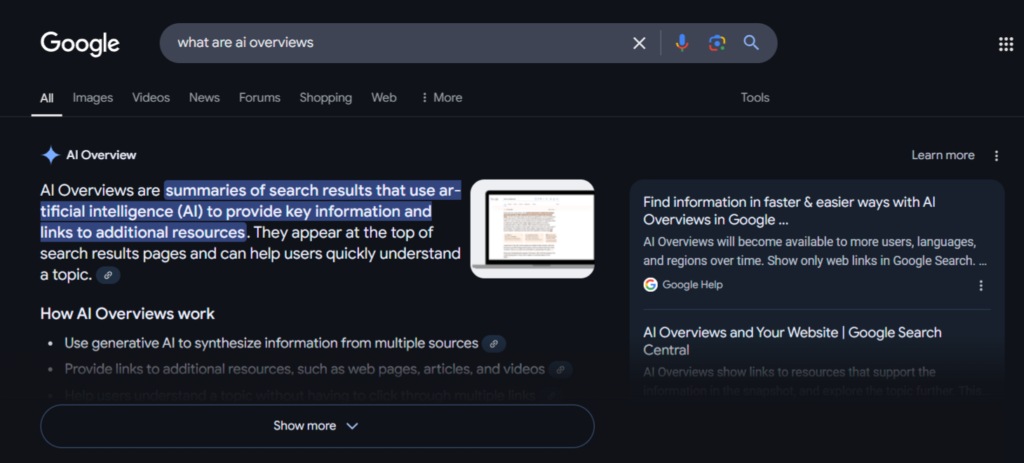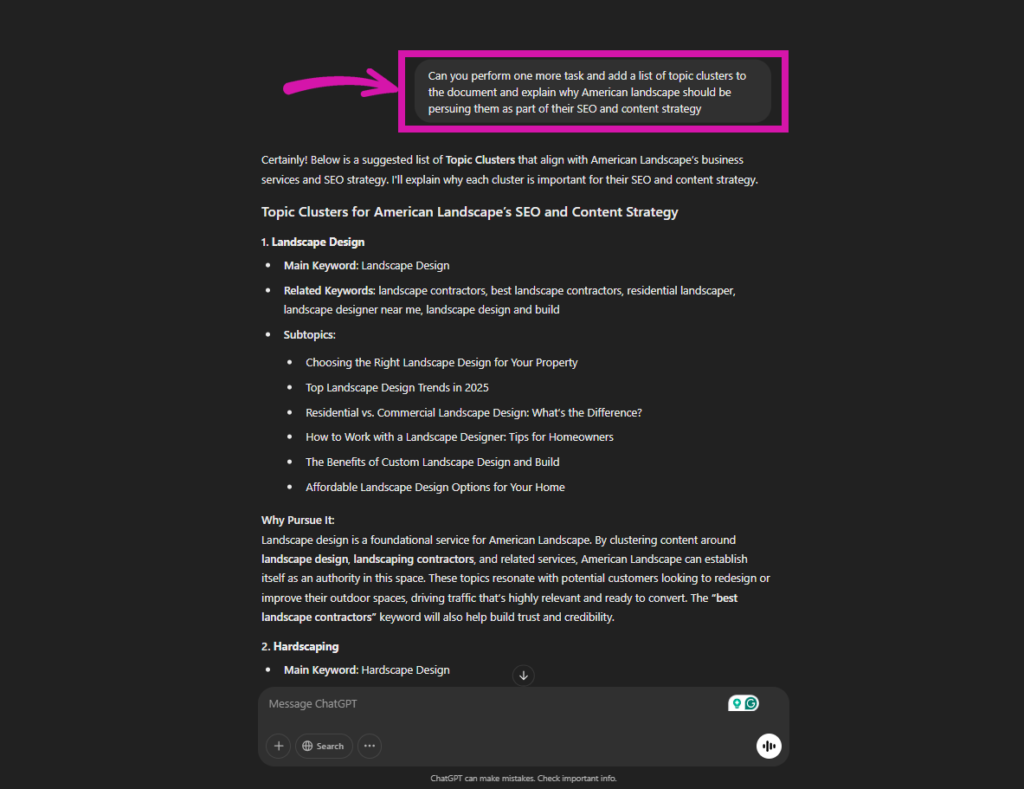(GEO) Generative Engine Optimization: AI’s Impact on SEO

When you started your current job, the transition was exciting and intimidating—you weren’t sure how it would impact you in the long run. Change is often unsettling, especially when it brings unknowns. The rapid evolution of technology presents a similar challenge, and few advancements have been as transformative as artificial intelligence.
AI is reshaping how we create, consume, and rank content, influencing industries and everyday experiences. One of the biggest shifts AI has introduced is Generative Engine Optimization (GEO), a strategy that helps content creators optimize for AI-generated search results.
Regardless of how you feel, AI remains, and it’s time to change how you approach content to make room for the new kid on the block.
That new kid comes with many acronyms, such as AIO, AEO, and GEO, joining the well-known SEO. I often feel like I’m back in kindergarten again, learning phonics and vowels as I try to keep the acronyms straight.

What do these changes and new acronyms mean for businesses, marketers, and content creators?
We’ll help dispel some of the overwhelming confusion and unlock AI’s potential in modern content.
The State of SEO in an AI-Driven World
You may have noticed the recent change in Google search. You can now view an AI summary at the top of the search engine results page, answering questions quickly without clicking on any links.
The AI summary is just the tip of the iceberg regarding how AI impacts search engines. In addition, ChatGPT and Perplexity show many other ways to answer common questions and create content.
In response, the next step in our AI journey is Generative Engine Optimization (GEO). It is the next evolution of SEO, focusing on showing up in AI generative text rather than traditional search engine results (though SEO remains important).
Here’s a look at several AI-based tools that will impact your GEO.
AIO: Optimizing Quick Answers Rather Than Search Results
AI Overviews (AIO) are Google’s AI-generated summaries that appear at the top of search engines. They provide direct answers to questions without users having to browse dozens of links looking for one with a relevant answer.

Source: Google
AI Overviews are becoming more prevalent, appearing in approximately 30% of searches and present in 74% of problem-solving queries. This shift means businesses must adjust content strategies to ensure visibility in AI-generated summaries.
While traditional results limit responses to a single source, AI Overview reviews several sources and summarizes an answer based on common themes in those sources.
How AI Overviews Change Search Behavior
AI summaries allow users to find answers directly, reducing search traffic to individual pages. More than a quarter of search results will include AI. Businesses must start adjusting their strategies around AI to avoid a dip in traffic. Already, 58.5% of US Google Searches don’t result in clicks.
AI Overviews also impact industries differently. Telecommunications experiences a 56% occurrence of AIOs, whereas beauty and cosmetics see only 14%. Understanding this variance is key to optimizing content effectively.
Additionally, while AI Overviews increase visibility for cited sources, they can also reduce click-through rates (CTR) for sites that are not directly cited. This means businesses must focus on structuring content to increase the likelihood of being referenced in AI summaries rather than relying solely on traditional rankings.
Studies indicate that 52% of AI Overview sources come from the top 10 search results, suggesting that higher-ranking pages are more likely to be cited. This further underscores the importance of traditional SEO practices alongside GEO strategies.
You still can gain traffic from AIO readers, as AIO includes citations and snippets to back their summaries. To do so, you must shift your thinking and strategies to GEO.
Studies Indicate that 52% of AI Overview sources come from the top 10 search results.
What You Can Learn from AIO About GEO
People want quick answers. AI tools aim to improve the user experience by weeding out extra information and focusing on the user’s wants and needs (also known as their user intent).
Generative Engine Optimization (GEO) is the practice of structuring content so AI search tools can easily find, summarize, and cite it in their generated responses.
Your content should prioritize user intent over all other strategies to stay relevant. It should contain easy-to-read snippets that AIOs can include in their summaries and responses. Content is no longer about long blog posts packed with keywords. It’s about understanding what information users want and providing it in an easy-to-read and scannable format that supports humans and AI alike.
Answer Engines: The Rise of Conversational AI Search
Google AI isn’t the only AI tool on the block.
Answer engines are question-and-answer tools. You can type in any question and receive a response generated from an information database.
Some examples of answer engines include ChapGPT and Perplexity. These tools can bring additional anxiety to content creators since users no longer need to use Google to find answers.
Why Answer Engines Matter for Visibility
Users can ask Siri or type questions using another answer tool without touching a search engine. However, those tools often search online for answers that they provide to users.
The responses are structured and easy to read, identifying the most relevant information. It’s no wonder users prefer that over pages of irrelevant information. About 48% of U.S. users trust AI-generated content, opening the door for more AI-run solutions.
Because of this shift, content must focus more on intent than keywords. Intent examines the reason and motivation behind a query and seeks to answer that question with quality information that AI tools are most likely to use in their responses.
One effective way to increase AI visibility is through high-quality backlinks. Search studies show that content with authoritative backlinks is more likely to be cited in AI Overviews, further emphasizing the importance of link-building strategies.
What You Can Learn from Answer Engines about GEO
Content structure and authority are key!
When these AI answer engines pull answers, they must:
1. Find the most relevant responses online.
2. Select the most authoritative answers.
If you can provide both factors in your content through well-structured content with easy-to-find answers backed by authority citations and experienced authors, you are golden!
GEO: Optimizing for AI-Generated Search Results
GEO is the next evolution of SEO, focusing on creating content optimized for AI Overview and answer engines.
I want to make a slight disclaimer here. By no means do I advocate for discontinuing SEO. SEO is still relevant as long as search boxes exist. However, GEO should become an equal priority to your SEO strategies.
The goal of GEO is to appear in searches and AI results. GEO helps content appear in AI-generated responses, ensuring it is easily found, cited, and ranked within AI-driven search tools like Google’s AI Overviews and answer engines. Meanwhile, SEO focuses on appearing in traditional search engine searches.
To optimize your content for AI, you need structured information that AI can easily find, search, and cite—helping drive users back to your site from AI tools. Applying the right strategies ensures your content remains visible and valuable in AI-driven search.
8 GEO Practices for Improved AI Search Results
If done well, incorporating GEO into your strategy can boost your visibility by nearly 40%. Use these eight best practices to get your strategy off to a good start.
1. Create Structured, High-Quality Content
Have you ever had a child ask you to separate their Play-Doh into colors after they combined all the colors into one indiscernible blob? It’s nearly impossible to differentiate between colors when they are intermixed. However, color-sorting items like Skittles is much easier as each Skittle is easily identifiable in a handful of colors.
When you combine all your information into giant paragraphs of text, you present AI with a Play-Doh-like glob of information from which it is challenging for AI to extract individual ideas.
Here are a few ways to improve your structure and create Skittles of content AI can easily pull out:
- Bulleted lists
- Clear headings
- Concise summaries
- Pull quotes
- Schema markup (for FAQs, How-Tos, and Articles)
You can also help AI identify and organize your content by providing context through topic clusters. A topic cluster uses a pillar page to note the primary topic and cluster pages to expand on that topic. Internal links connect between the pillar content and clusters of related topics.

2. Answer Queries Directly
It is rare to find a recipe blog that begins with the recipe itself. Most recipe blogs start with the recipe’s backstory, followed by several personal anecdotes. Most people don’t care about those anecdotes when they simply want to know how many chocolate chips their cookies need.
AI responds similarly to meandering content.
If you want AI to identify the answer, use simple, straightforward answers to common inquiries. Many content creators have had great success using a Q&A format. You can’t get much more concise than asking common search queries word-for-word followed by one or two-sentence answers. Even if you expand on those topics in your blog post body, ending with a Q&A section helps you capture those AI results.
3. Exhibit Authority and Trustworthiness
AI engines prioritize authority content.
Would you accept medical advice from a doctor with a PhD or your neighbor Bob, who owns a garage? Then, when your car makes an odd hissing noise, which one would you go to?
AI engines look for signs of authority on a specific topic to support claims. In addition, 90% of customers prioritize authenticity as a factor in trust. Authority in your niche matters to AI and human readers alike!
Google refers to these authority signs as E-E-A-T (Experience, Expertise, Authority, Trustworthiness). These factors help Google identify content from a place of personal experience and education that others can trust.
Some signs you can include to vouch for your expertise on a topic include:
- Citation links to credible sources
- First-party data
- Structured references
- Factual accuracy
- Author bios
- Case studies
4. Build Domain Authority Through Backlinks
One of the best ways to build credibility and authority is through backlinks.
Backlinks will significantly impact what marketers call domain authority or how trustworthy a website’s domain is. A backlink is a link from a third-party site to your website or domain.
Whenever someone links back to your website, they say it is trustworthy and worth quoting or citing.
You can build backlinks from guest posts on other sites, citing websites that might link back to you in return and through public relations.
5. Optimize for Conversational Search and NLP
AI uses natural language processing (NLP) to analyze and use natural language queries. NLP enables AI to understand voice searches from questions users ask and respond conversationally to search queries in voice search apps.
When you write, mirror a conversational, easy-to-understand tone that supports AI’s NLP. Also, consider incorporating exact-match questions written in a natural language format.
For example, traditional keyword SEO focused on terms like “content marketing” or “best content marketing tools.” However, with the rise of natural language queries and voice searches, you will see more long-tail keywords like “What are the best marketing tools?” and “What does content marketing mean?” These queries are used to optimize content and gain more traffic without much competition.
6. Add AI-Friendly Content Formats and Multimedia Optimization
Paragraphs of text are for human readers who sit down and read through the whole page. However, if you also want to write for AI, you need a more varied approach. Diversifying your content is beneficial because it appeals more to AI and makes you more engaging for your human audience.
Here are some tips for creating engaging, AI-friendly content:
- Create organized lists that summarize ideas.
- Add FAQs that answer common long-tail keyword questions.
- Create step-by-step guides with instructions.
- Use a mixture of text, images, videos, and interactive media.
- Optimize all media, such as video and pictures, using alt-text, optimized captions, and structured data.
- Embed your video on your website rather than linking to YouTube so AI can cite your website.
7. Perform Technical SEO and Performance for AI Readability
What goes on behind the scenes on your website impacts your authority and ranking.
It doesn’t matter how cool a car works. If the transmission is on its last leg and the engine smokes, no one would trust driving the vehicle.
The same is true for your website. You could have high-authority content that checks all the SEO boxes. But, if the web page won’t load and the site looks like it stepped out of the 90s, most people, especially AI, won’t even read your content.
Conduct technical SEO to ensure your site’s technical aspects are in order. Check your:
- Page load speed
- Navigation
- Design and User Interface
- Interactivity
- Visual stability
- Image load speeds
Ensure the entire site is very human (and AI) user-friendly. Regular site maintenance monitors the site to catch issues before they impact its authority (e.g. if a page goes offline or a link is broken).
8. Schedule Frequent Content Updates for Real-Time Relevance
I was watching a movie that dated itself the moment a character pulled out a flip phone rather than a smartphone. It was just a small moment, but in an instant, everyone watching the movie knew it was an “older” film.
Having outdated information, dates, and news on your content instantly dates it. They are like flip phones showing up in a smartphone world, signaling to everyone reading that everything else in your content might not be the most updated information.
To avoid losing readers and AI, keep your content updated with the latest stats, terminology, and information to remain relevant and timely.
Performing regular content audits helps with this process. You can identify and update outdated articles before losing traffic from that content.
You will also want to monitor how AI displays your past content and update formats based on the latest AI tools and apps to ensure all your content supports the latest AI models.
The Future of GEO – Preparing for AI-First Search
AI-generated search will continue replacing traditional search rankings, shifting toward contextual, real-time responses instead of keyword-based search. If you want to retain and increase your current traffic, it’s time to update your SEO and add GEO into your strategy to help you rank in AI Overviews and answer tools.
GEO has shown us that it is here for the long haul and worth the investment. It has become foundational to how people find and interact with online content.
Do you need help adjusting from SEO-focused content to GEO-focused content?
Contact us today to ensure your content stays relevant in an AI-driven world.